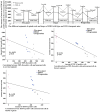The Overexpression of TDP-43 Protein in the Neuron and Oligodendrocyte Cells Causes the Progressive Motor Neuron Degeneration in the SOD1 G93A Transgenic Mouse Model of Amyotrophic Lateral Sclerosis
- PMID: 27570488
- PMCID: PMC4997058
- DOI: 10.7150/ijbs.15938
The Overexpression of TDP-43 Protein in the Neuron and Oligodendrocyte Cells Causes the Progressive Motor Neuron Degeneration in the SOD1 G93A Transgenic Mouse Model of Amyotrophic Lateral Sclerosis
Abstract
The recent investigation suggested that the TDP-43 protein was closely related to the motor neuron degeneration in amyotrophic lateral sclerosis (ALS), but the pathogenesis contributed to motor neuron degeneration largely remained unknown. Therefore, we detected the alteration of TDP-43 expression and distribution in the adult spinal cord of the SOD1 G93A transgenic mouse model for searching the possible pathogenesis of ALS. We examined the TDP-43 expression and distribution in the different anatomic regions, segments and neural cells in the adult spinal cord at the different stages of the SOD1 wild-type and G93A transgenic model by the fluorescent immunohistochemical technology. We revealed that the amount of TDP-43 positive cell was cervical>lumbar>thoracic segment, that in the ventral horn was more than that in the dorsal horn, a few of TDP-43 protein sparsely expressed and distributed in the other regions, the TDP-43 protein weren't detected in the white matter and the central canal. The TDP-43 protein was mostly expressed and distributed in the nuclear of neuron cells and the cytoplasm of oligodendrocyte cells of the gray matter surrounding the central canal of spinal cord by the granular shape in the SOD1 wild-type and G93A transgenic mice. The amount of TDP-43 positive cell significantly increased at the onset and progression stages of ALS following with the increase of neuron death in spinal cord, particularly in the ventral horn of cervical segment at the progression stage. Our results suggested that the overexpression of TDP-43 protein in the neuron and oligodendrocyte cell causes the progressive motor neuron degeneration in the ALS-like mouse model.
Keywords: Amyotrophic lateral sclerosis. Animal models. Mechanism of neurodegenerative diseases. Motor neuron diseases. Motor neuron. Neurodegeneration. Neurodegenerative disease. SOD1. Transgenic mice..
Conflict of interest statement
The authors have declared that no competing interest exists.
Figures










Similar articles
-
Pathological Modification of TDP-43 in Amyotrophic Lateral Sclerosis with SOD1 Mutations.Mol Neurobiol. 2019 Mar;56(3):2007-2021. doi: 10.1007/s12035-018-1218-2. Epub 2018 Jul 7. Mol Neurobiol. 2019. PMID: 29982983 Free PMC article.
-
Aldehyde Dehydrogenases 1A2 Expression and Distribution are Potentially Associated with Neuron Death in Spinal Cord of Tg(SOD1*G93A)1Gur Mice.Int J Biol Sci. 2017 Apr 10;13(5):574-587. doi: 10.7150/ijbs.19150. eCollection 2017. Int J Biol Sci. 2017. PMID: 28539831 Free PMC article.
-
Changes in the Expression of FUS/TLS in Spinal Cords of SOD1 G93A Transgenic Mice and Correlation with Motor-Neuron Degeneration.Int J Biol Sci. 2016 Sep 14;12(10):1181-1190. doi: 10.7150/ijbs.16158. eCollection 2016. Int J Biol Sci. 2016. PMID: 27766033 Free PMC article.
-
Altered expression of atypical PKC and Ryk in the spinal cord of a mouse model of amyotrophic lateral sclerosis.Dev Neurobiol. 2014 Aug;74(8):839-50. doi: 10.1002/dneu.22137. Epub 2014 Jan 22. Dev Neurobiol. 2014. PMID: 24123880 Free PMC article. Review.
-
From Mouse Models to Human Disease: An Approach for Amyotrophic Lateral Sclerosis.In Vivo. 2018 Sep-Oct;32(5):983-998. doi: 10.21873/invivo.11339. In Vivo. 2018. PMID: 30150420 Free PMC article. Review.
Cited by
-
All-Trans Retinoic Acid Exerts Neuroprotective Effects in Amyotrophic Lateral Sclerosis-Like Tg (SOD1*G93A)1Gur Mice.Mol Neurobiol. 2020 Aug;57(8):3603-3615. doi: 10.1007/s12035-020-01973-8. Epub 2020 Jun 17. Mol Neurobiol. 2020. PMID: 32548665
-
Blood-brain barrier dysfunction and myelin basic protein in survival of amyotrophic lateral sclerosis with or without frontotemporal dementia.Neurol Sci. 2022 May;43(5):3201-3210. doi: 10.1007/s10072-021-05731-z. Epub 2021 Nov 26. Neurol Sci. 2022. PMID: 34826032
-
Assessing neuraxial microstructural changes in a transgenic mouse model of early stage Amyotrophic Lateral Sclerosis by ultra-high field MRI and diffusion tensor metrics.Animal Model Exp Med. 2020 Apr 16;3(2):117-129. doi: 10.1002/ame2.12112. eCollection 2020 Jun. Animal Model Exp Med. 2020. PMID: 32613171 Free PMC article.
-
Pathological Modification of TDP-43 in Amyotrophic Lateral Sclerosis with SOD1 Mutations.Mol Neurobiol. 2019 Mar;56(3):2007-2021. doi: 10.1007/s12035-018-1218-2. Epub 2018 Jul 7. Mol Neurobiol. 2019. PMID: 29982983 Free PMC article.
-
VEGF expression disparities in brainstem motor neurons of the SOD1G93A ALS model: Correlations with neuronal vulnerability.Neurotherapeutics. 2024 Apr;21(3):e00340. doi: 10.1016/j.neurot.2024.e00340. Epub 2024 Mar 11. Neurotherapeutics. 2024. PMID: 38472048 Free PMC article.
References
-
- Strong MJ, Volkening K, Hammond R, Yang W, Strong W, Leystra-Lantz C. et al. TDP43 is a human low molecular weight neurofilament (hNFL) mRNA-binding protein. Molecular and cellular neuroscience. 2007;35:320–7. - PubMed
-
- Wang IF, Wu LS, Chang HY, Shen CK. TDP-43, the signature protein of FTLD-U, is a neuronal activity-responsive factor. Journal of neurochemistry. 2008;105:797–806. - PubMed
Publication types
MeSH terms
Substances
LinkOut - more resources
Full Text Sources
Other Literature Sources
Medical
Molecular Biology Databases
Miscellaneous

